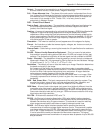
Appendix A • Reference Information
Extron • Matrix 3200/6400 Series • User’s ManualA-7
Component Video – Our color television system starts with three channels of
information; Red, Green, & Blue (RGB). In the process of translating these channels
to a single composite video signal they are often first converted to Y, R-Y, and B-Y.
Both 3-channel systems, RGB and Y, R -Y, B -Y are component video signals. They
are the components that eventually make up the composite video signal. Much
higher program production quality is possible if the elements are assembled in the
component domain.
Composite Sync – A signal consisting of horizontal sync pulses, vertical sync pulses,
and equalizing pulses only, with no signal reference level.
Composite Video – A mixed signal comprised of the luminance (black and white),
chrominance (color), blanking pulses, sync pulses and color burst.
Contrast – The range of light and dark values in a picture or the ratio between the
maximum and the minimum brightness values. Low contrast is shown mainly as
shades of gray, while high contrast is shown as blacks and whites with very little
gray. It is also a TV monitor adjustment which increases or decreases the level of
contrast of a televised picture.
Crosstalk – Interference from an adjacent channel which adds an undesirable signal to
the desired signal.
Crosstalk Isolation – Attenuation of an undesired signal introduced by crosstalk from an
adjacent channel.
CRT – Cathode Ray Tube – A vacuum tube that produces light when energized by the
electron beam generated inside the tube. A CRT has a heater element, cathode, and
grids in the neck of the tube, making up the “gun”. An electron beam is produced by
the gun and is accelerated toward the front display, or screen surface of the tube.
The display surface contains phosphors that light up when hit by the electron beam.
The CRT is more commonly known as picture tube.
dB – Decibel – The standard unit used to express gain or loss of power. It indicates the
logarithmic ratio of output power divided by input power. A power loss of 3 dB is an
attenuation of half of the original value. The term “3dB down” is used to describe the
“half power point”.
DC – Direct Current – The flow of electrons in one direction.
D Connector – A connector with rounded corners and angled ends, taking on the shape
of the letter “D”. Commonly used in computers and video.
Decibel – See dB.
Decoder – A device used to separate the RGBS (Red, Green, Blue and Sync) signals
from a composite video signal.
Differential Audio – See Balanced Audio.
Distribution Amplifier (DA) – A device that allows connection of one input source to
multiple output sources such as monitors or projectors.
FCC – Federal Communications Commission – A unit of the U.S. Government that
monitors and regulates communications.
Field – In interlaced video, it takes two scans on a screen to make a complete picture, or
a “Frame”. Each scan is called a “Field”. Sometimes these are referred to as “field 1
and field 2”.
Flicker – Flicker occurs when the electron gun paints the screen too slowly, giving the
phosphors on the screen time to fade.
Frame – In interlaced video, a Frame is one complete picture. A Frame is made up of
two fields, or two sets of interlaced lines.
Frequency Range – Refers to the low-to-high limits of a device, such as a computer,
projector or monitor. Also “bandwidth”.
Gain – A general term used to denote an increase in signal power or voltage produced
by an amplifier in transmitting a signal from one point to another. The amount of gain
is usually expressed in decibels above a reference level. Opposite of Attenuation.
Genlock – A method of synchronizing video equipment by using a common, external
“Genlock” signal.
Hertz – Hz – A measure of frequency in cycles per second.


















